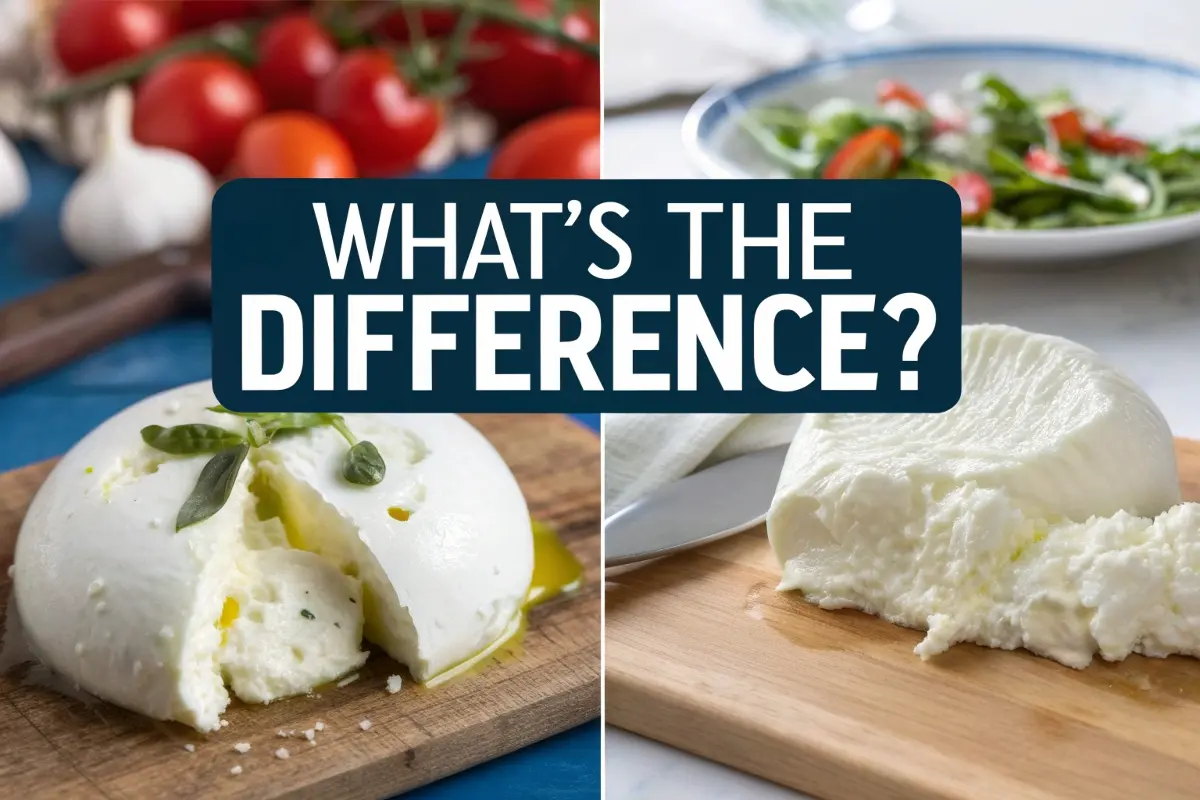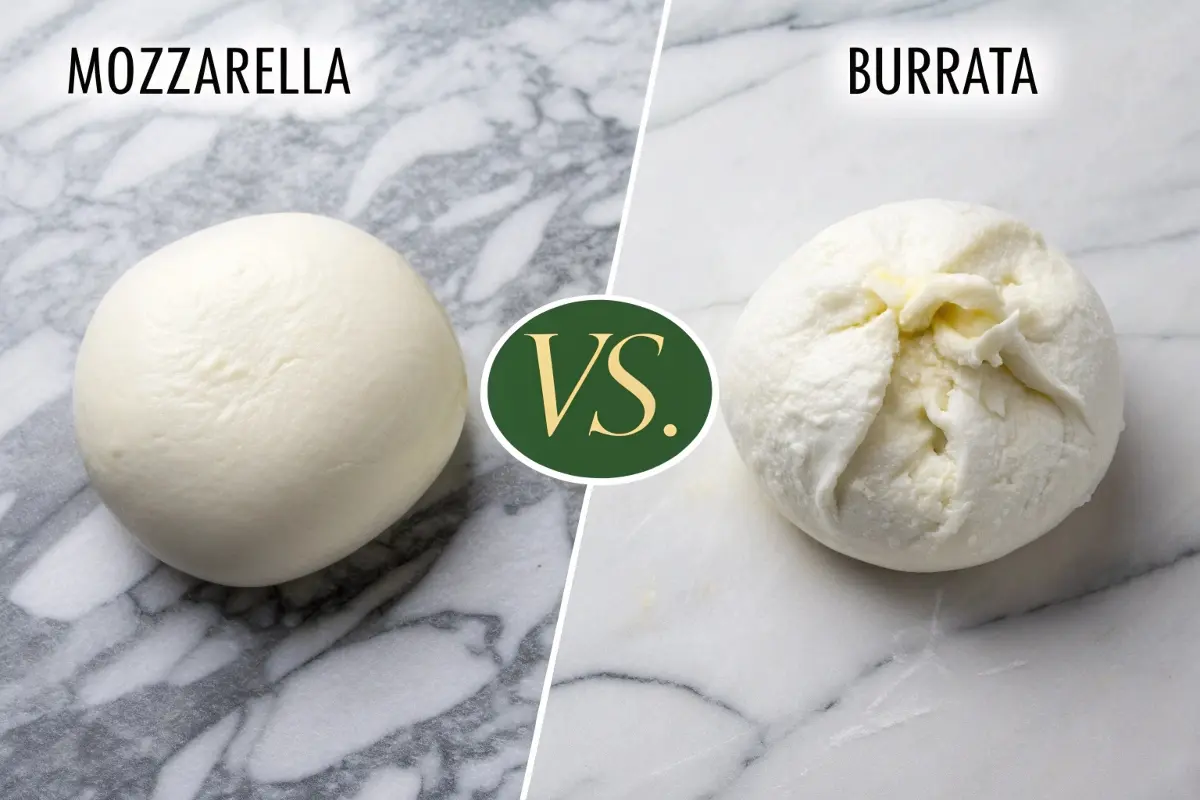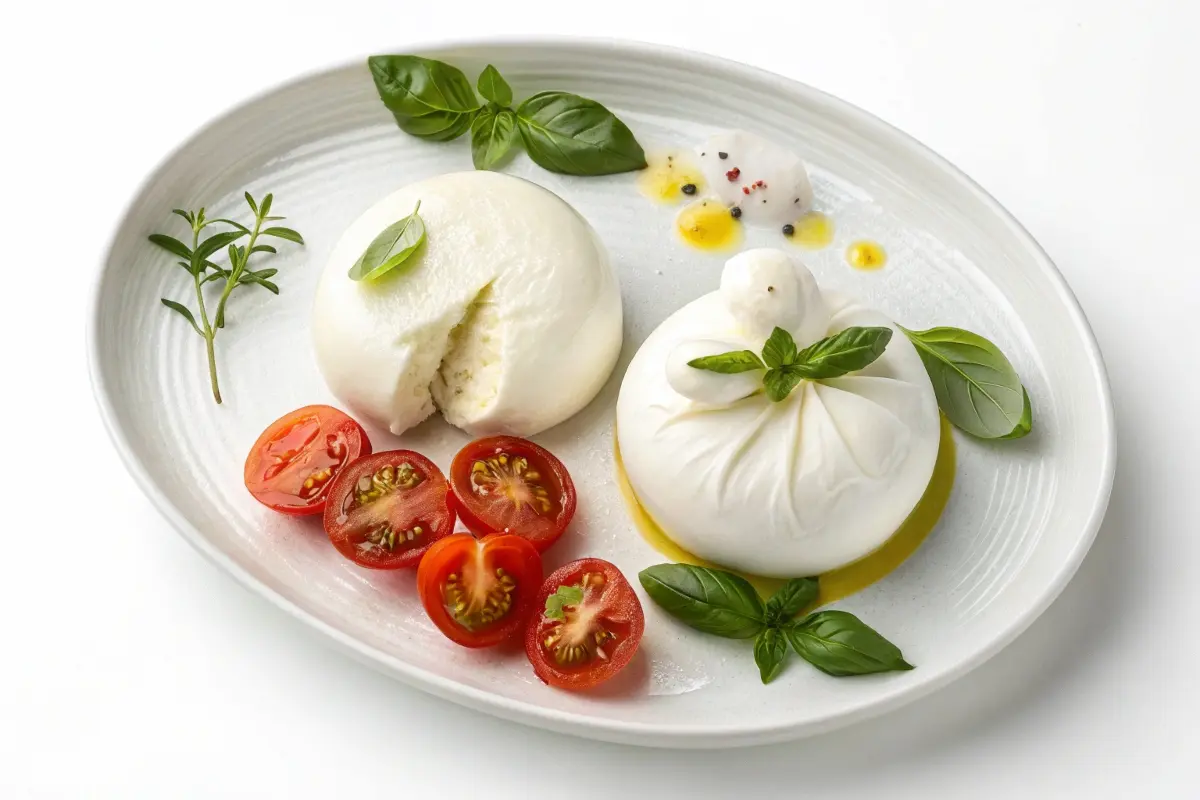Understanding Burrata vs. Mozzarella: Are They the Same?
When it comes to Italian cheeses, few names are as celebrated as burrata and mozzarella. They’re staples in kitchens worldwide and often confused due to their similar appearance. However, their unique characteristics set them apart. Let’s explore these cheeses in detail to clarify the confusion!

What Is Burrata Cheese? Is It Like Mozzarella?
Burrata is a fresh Italian cheese that takes indulgence to a whole new level. It consists of a soft outer shell made from mozzarella, encasing a creamy center of stracciatella and cream. Originally from the Puglia region of Italy, burrata is prized for its luxurious texture and versatility in recipes.
- Fun Fact: The name “burrata” is derived from the Italian word “burro,” meaning butter. 🧈 That’s how rich and creamy it is!
What Is Mozzarella Cheese, and How Does It Compare to Burrata?
Mozzarella, another iconic Italian cheese, is equally famous but quite different in its structure and use. Made from buffalo or cow’s milk, mozzarella is a semi-soft, fresh cheese with a smooth, elastic texture. Its mild flavor and versatility make it a staple in many dishes, from pizzas and caprese salads to paninis and lasagnas.
Unlike burrata, mozzarella doesn’t have a creamy center. Instead, it’s all about that stretchy, melt-in-your-mouth consistency that cheese lovers adore.
- Tip: For the best flavor, opt for fresh mozzarella stored in water. It’s softer and fresher than the pre-shredded versions often found in supermarkets.
Key Differences Between Burrata and Mozzarella Cheese
To truly understand the distinction, let’s break down the key differences between burrata and mozzarella.
Is Burrata More Creamy Than Mozzarella?
Mozzarella has a smooth, stretchy, and slightly firm texture. Burrata, on the other hand, feels delicate and creamy due to its soft outer shell and luscious interior. Cutting into burrata reveals a rich, almost liquid center that sets it apart from mozzarella.
How Do Burrata and Mozzarella Taste?
Mozzarella is mild, slightly salty, and buttery. It pairs well with a variety of ingredients without overpowering them. Burrata, with its creamy center, has a richer and more indulgent taste. The creaminess adds a luxurious element that makes burrata a star ingredient in dishes.
Are Burrata and Mozzarella Made the Same Way?
Both cheeses have Italian roots but are produced differently. Mozzarella is traditionally made by heating and stretching curds to create its elastic texture. Burrata, however, is a more intricate process, involving forming a pouch of mozzarella and filling it with cream and stracciatella.
Nutritional Comparison
| Cheese | Calories (per 100g) | Protein | Fat | Carbs |
|---|---|---|---|---|
| Mozzarella | 280 | 28g | 17g | 1g |
| Burrata | 334 | 17g | 28g | 2g |
Mozzarella is a slightly leaner option, making it ideal for those watching their calorie intake. Burrata, while higher in fat, is perfect for indulgent occasions.
Culinary Uses for Burrata and Mozzarella Cheese
While there are plenty of differences, burrata and mozzarella share a few commonalities.
When to Choose Burrata Over Mozzarella
Both cheeses start with similar ingredients: milk, rennet, and salt. It’s the process that gives each cheese its unique qualities.
Best Dishes to Use Mozzarella Cheese Instead of Burrata
Both burrata and mozzarella are incredibly versatile and pair beautifully with Mediterranean ingredients like tomatoes, basil, and olive oil. Whether you’re topping a pizza or crafting a salad, either cheese will elevate your dish.
How Burrata Is Made
Making burrata is an art. Traditionally, mozzarella curds are stretched into a soft pouch. This pouch is filled with a mixture of stracciatella (shredded mozzarella mixed with cream) and sealed with precision.
Regional Variations in Burrata
In some regions of Italy, burrata includes unique local ingredients like truffles or herbs, making it a specialty product that varies by region.
How Mozzarella Is Made
Mozzarella is crafted through a simpler process called pasta filata, where cheese curds are heated and stretched to achieve its elastic texture.
Types of Mozzarella: Fresh, Aged, and Smoked
Mozzarella comes in different varieties:
- Fresh Mozzarella: Soft and moist, best enjoyed within a few days.
- Aged Mozzarella: Firmer and perfect for shredding over pizza.
- Smoked Mozzarella: Adds a subtle smokiness to recipes, elevating the flavor.
Common Misconceptions About Burrata and Mozzarella
Why Are They Confused?
The confusion largely stems from their appearance. Both cheeses are white, round, and made from similar ingredients. However, their textures and uses couldn’t be more different.
How to Distinguish Burrata from Mozzarella at a Glance
The easiest way to tell the difference? Cut it open! If it has a creamy center, it’s burrata. If it’s uniformly firm, it’s mozzarella.

Culinary Applications: Burrata vs. Mozzarella
Ideal Recipes for Burrata
Burrata shines in simple dishes that allow its creamy center to be the highlight. Examples include:
- Burrata Caprese with fresh tomatoes and basil 🍅
- Burrata on toasted bread with olive oil
- Burrata as a topping for gourmet pizzas
Recipes Where Mozzarella Shines
Mozzarella is a workhorse in the kitchen, excelling in:
- Classic Margherita pizza
- Baked lasagna with stretchy layers of cheese
- Fresh mozzarella slices in a caprese salad
Is Burrata the Same as Mozzarella in Terms of Storage?
When it comes to storage, burrata and mozzarella have distinct requirements to preserve their texture and flavor. Improper storage can ruin their unique qualities, so it’s essential to handle these cheeses with care.
How to Store Burrata Cheese
Burrata’s delicate structure and creamy filling make it more perishable than mozzarella. It’s typically sold in a brine or whey-filled container to maintain freshness. For the best taste and texture:
- Refrigerate Immediately: Keep burrata in its original container, submerged in the liquid.
- Consume Quickly: Burrata is best eaten within 24–48 hours after purchase. The creamy center begins to break down and lose flavor over time.
- Avoid Freezing: Freezing burrata destroys its creamy texture, making it grainy and less enjoyable.
Storing Mozzarella: Does It Last Longer Than Burrata?
Mozzarella, especially fresh mozzarella, also requires careful handling to maintain its elasticity and mild flavor. Here’s how to store it:
- Fresh Mozzarella: Keep it in its liquid (usually water or whey) and refrigerate it for up to five days. Change the liquid daily to maintain freshness.
- Aged Mozzarella: Block or shredded mozzarella can be wrapped tightly in plastic or stored in an airtight container. It has a longer shelf life—up to two weeks in the fridge or several months in the freezer.
- Pro Tip: If fresh mozzarella starts to dry out, you can soak it in lightly salted water for an hour to restore moisture.
Common Problems and Solutions When Using Burrata and Mozzarella
Both burrata and mozzarella are delightful to work with, but even experienced cooks can face challenges. Let’s address the most common problems and how to solve them.
Burrata Leakage or Spoilage Issues
Due to its soft center, burrata can easily leak if handled roughly. It’s also highly perishable, so spoilage is a frequent concern.
Solution:
- Always transport burrata in a secure container and avoid piercing the outer shell until ready to serve.
- Check the expiration date before buying, and ensure it’s stored in a cold environment at all times.
Mozzarella Drying Out or Becoming Rubbery
Mozzarella’s texture can sometimes become rubbery or dry, especially if overcooked or stored improperly.
Solution:
- Use fresh mozzarella whenever possible and avoid overbaking it, as high heat can make it tough.
- For block mozzarella, grate it when cold and let it come to room temperature before adding it to dishes for even melting.

FAQs About Burrata and Mozzarella
Can You Substitute Burrata for Mozzarella in Recipes?
Yes, but with limitations. Burrata’s creamy center makes it unsuitable for high-heat cooking, like pizzas or casseroles. However, it works wonderfully as a substitute in cold dishes like caprese salads or as a topping for flatbreads.
Is Burrata Halal?
Burrata can be halal, but it depends on how it’s made. The key ingredient to check is the rennet used during production. Some burrata is made with animal rennet, which may not meet halal requirements, while others use microbial or vegetable rennet, which is halal-friendly. Always check the label or contact the manufacturer to confirm.
Why Is Burrata So Expensive?
Burrata’s price reflects its craftsmanship and perishability. It requires skilled artisans to create the delicate mozzarella shell and creamy stracciatella filling. Additionally, burrata has a short shelf life, meaning it must be made fresh and consumed quickly, which adds to production and transportation costs. The luxurious, creamy texture also makes it a premium product worth savoring.
Do You Eat the Skin on Burrata?
Yes, you absolutely eat the skin on burrata! The outer layer is made of mozzarella, which is both edible and delicious. It provides a delicate casing for the creamy interior, offering a lovely contrast in texture when you bite into it.
What Are the Best Pairings for Each Cheese?
Burrata pairs beautifully with:
- Heirloom tomatoes 🍅
- Fresh figs and honey 🍯
- Crusty sourdough bread 🥖
Mozzarella is more versatile and works well with:
- Pesto or balsamic glaze
- Prosciutto and melon
- Roasted vegetables
Which Cheese Is Healthier?
Mozzarella is generally the healthier option, thanks to its lower fat and calorie content. Burrata, while richer and creamier, is higher in fat and best enjoyed in moderation.
Why Does Burrata Have a Shorter Shelf Life?
The cream inside burrata is highly perishable and starts breaking down quickly. Mozzarella, being more solid, lasts longer under proper refrigeration.
How Can I Tell If My Cheese Has Gone Bad?
Spoiled burrata or mozzarella may have an off smell, slimy texture, or visible mold. If you notice any of these signs, it’s best to discard the cheese.
Is Burrata Worth the Extra Cost?
Absolutely! While burrata is more expensive than mozzarella, its luxurious creaminess adds an unparalleled flavor to dishes. Think of it as a treat for special occasions.
Culinary Applications: Recipe with Burrata
Let’s put burrata in the spotlight with a simple yet elegant recipe: Burrata Caprese Salad.
Ingredients:
- 2 fresh burrata balls
- 4 ripe heirloom tomatoes, sliced
- Fresh basil leaves 🌿
- Extra virgin olive oil 🫒
- Balsamic glaze
- Sea salt and cracked black pepper
Preparation:
- Arrange tomato slices on a large serving platter.
- Place the burrata balls in the center, leaving them whole for a dramatic presentation.
- Scatter fresh basil leaves over the tomatoes and burrata.
- Drizzle with olive oil and balsamic glaze.
- Sprinkle with salt and pepper to taste.
- Serve immediately with crusty bread for scooping up the creamy burrata.
This dish is simple to prepare but bursts with fresh, summery flavors. The creaminess of the burrata pairs beautifully with the acidity of the tomatoes and the sweetness of the balsamic glaze.
Conclusion: Embracing Burrata and Mozzarella in Your Kitchen
So, is burrata the same as mozzarella? While they share some similarities, these two Italian cheeses couldn’t be more distinct. Burrata offers a rich, creamy indulgence perfect for fresh salads and appetizers, while mozzarella shines in its versatility and elasticity, making it a go-to for pizzas, pastas, and more.
Next time you’re at the grocery store or dining at an Italian restaurant, consider the dish you’re preparing or craving. Will the luscious creaminess of burrata suit your plate, or is the stretchy goodness of mozzarella calling your name? Either way, these cheeses promise to bring the authentic taste of Italy to your table.
